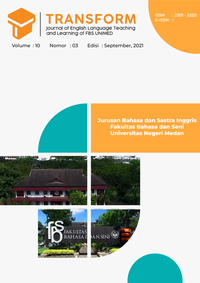Language Style Used in Novel œDilan: Dia adalah Dilanku (Tahun 1990)
DOI:
https://doi.org/10.24114/tj.v10i3.44108Keywords:
Language Style, Novel, SociolinguisticsAbstract
This study deals with the language styles used in œDilan: Dia adalah Dilanku Tahun 1990 novel by Pidi Baiq. The objectives of this study are to find out the types of language styles, the realization of the types, and the reason why the types of language styles used by the main character in the novel. The study was conducted by using by using descriptive qualitative method. The data were taken from Dilan™s utterances, as the main character, in the novel. The technique of collecting the data was transcribing the data from the novel and then eliminating the data to be analyzed. After analyzing the data, it was found that there were five types of language style used by Dilan with the consultative style for most contributing style (79,4%) of all usage, followed by casual style, formal style, frozen style, and intimate style.Downloads
Published
2023-03-14
Issue
Section
Articles
License
Copyright (c) 2023 Hartati Hartati, Meisuri Meisuri

This work is licensed under a Creative Commons Attribution-ShareAlike 4.0 International License.
Authors who publish with this journal agree with the following terms:
- Authors retain copyright and grant the journal right of first publication with the work simultaneously licensed under a Creative Commons Attribution License that allows others to share the work with an acknowledgment of the work's authorship and initial publication in this journal.
- Authors are able to enter into separate, additional contractual arrangements for the non-exclusive distribution of the journal's published version of the work (e.g., post it to an institutional repository or publish it in a book), with an acknowledgment of its initial publication in this journal.
- Authors are permitted and encouraged to post their work online (e.g., in institutional repositories or on their website) prior to and during the submission process, as it can lead to productive exchanges, as well as earlier and greater citation of published work (See The Effect of Open Access).
- This work is licensed under a Creative Commons Attribution-ShareAlike 4.0 International License.

This work is licensed under a Creative Commons Attribution-NonCommercial-ShareAlike 4.0 International License.



